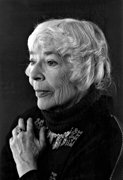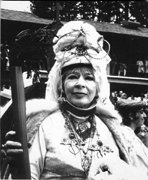 A great teacher inspires a new and authentic understanding of the world. Anyone who knew the artist and art history professor Mary Holmes (1910-2002), whether as a lecturer during a career that spanned six decades or as a friend, would agree that she was such a teacher. Keenly sensitive to the nature of art and the complexities of life, she communicated her perceptions with the authority of a sage and the timing of a great comic. Her mythological paintings of virtues and gifts of the spirit such as faith, hope, and self-discipline make visible those invisible realities, providing insight into the relation between our physical and spiritual lives. When she was a child, Mary recalled, people used to assign to a newborn girl the verse from the thirty-first chapter of the Book of Proverbs that corresponded to the date of her birth. The eighth verse reads, “Open thy mouth for the dumb in the cause of all such as are appointed to destruction.” Mary always felt this verse to be a calling and an inspiration to speak for those who could not speak for themselves: for animals appointed to destruction, for oddball human beings, and for all audiences who could not articulate the meaning of their own experience of art and of life.
A great teacher inspires a new and authentic understanding of the world. Anyone who knew the artist and art history professor Mary Holmes (1910-2002), whether as a lecturer during a career that spanned six decades or as a friend, would agree that she was such a teacher. Keenly sensitive to the nature of art and the complexities of life, she communicated her perceptions with the authority of a sage and the timing of a great comic. Her mythological paintings of virtues and gifts of the spirit such as faith, hope, and self-discipline make visible those invisible realities, providing insight into the relation between our physical and spiritual lives. When she was a child, Mary recalled, people used to assign to a newborn girl the verse from the thirty-first chapter of the Book of Proverbs that corresponded to the date of her birth. The eighth verse reads, “Open thy mouth for the dumb in the cause of all such as are appointed to destruction.” Mary always felt this verse to be a calling and an inspiration to speak for those who could not speak for themselves: for animals appointed to destruction, for oddball human beings, and for all audiences who could not articulate the meaning of their own experience of art and of life.
 Mary was graduated from Hollins College in Virginia in 1931. She received a Master’s degree in Art in 1941 from the State University of Iowa and taught Art History there and at Ohio State University. In 1953 she moved to the University of California, Los Angeles, and in 1965 became one of the original faculty members to be recruited to teach at Cowell College, the first college at the University of California, Santa Cruz. She taught there until she retired in 1975. For nearly thirty years, Mary also co-led the Penny University, the weekly public conversation group held in downtown Santa Cruz.To those who heard her once and those who heard her again and again Mary’s lectures provided fresh and living insights into the experience of life and art. And she could also have them laughing uproariously. “People say I’m so witty,” she observed in later years, “but I’m not witty at all. I think it’s that people laugh when they hear the truth spoken, because people simply delight in the truth.” And her lectures offered genuine revelations; many people, twenty years after hearing her talk, remember exactly what she said because her words so much changed the way they looked at the world around them. Some of the titles of her lectures and lecture series include “Why Art?” “Can Anybody Love Art?” “Art and the Inner Life,” “Beauty,” “Can Art Be Underground Now?” “The Universality of Art,” and “The End of Art.”
Mary was graduated from Hollins College in Virginia in 1931. She received a Master’s degree in Art in 1941 from the State University of Iowa and taught Art History there and at Ohio State University. In 1953 she moved to the University of California, Los Angeles, and in 1965 became one of the original faculty members to be recruited to teach at Cowell College, the first college at the University of California, Santa Cruz. She taught there until she retired in 1975. For nearly thirty years, Mary also co-led the Penny University, the weekly public conversation group held in downtown Santa Cruz.To those who heard her once and those who heard her again and again Mary’s lectures provided fresh and living insights into the experience of life and art. And she could also have them laughing uproariously. “People say I’m so witty,” she observed in later years, “but I’m not witty at all. I think it’s that people laugh when they hear the truth spoken, because people simply delight in the truth.” And her lectures offered genuine revelations; many people, twenty years after hearing her talk, remember exactly what she said because her words so much changed the way they looked at the world around them. Some of the titles of her lectures and lecture series include “Why Art?” “Can Anybody Love Art?” “Art and the Inner Life,” “Beauty,” “Can Art Be Underground Now?” “The Universality of Art,” and “The End of Art.”
